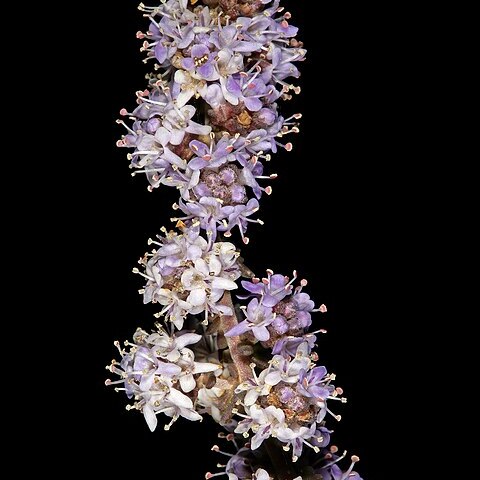Woody shrublet, stems several tufted from a woody stock, c. 150-600 mm long, erect or decumbent, branching more or less virgate, lax, young parts puberulous, hairs up to 0.1-0.15 mm long, more or less retrorse, closely leafy. Leaves opposite or subopposite, alternate upwards, fascicled, sometimes weakly so, largest primary leaves 6-15(-25) x 0.7-2(-2.3) mm (width depending on how tightly the margins are rolled), axillary leaves similar but smaller, all oblong, narrowly elliptic or narrowly oblanceolate, apex subobtuse to acute, base slightly narrowed, margins entire, revolute, both surfaces puberulous, hairs up to 0.1 mm long, almost velvety in western part of range, almost scabridulous in eastern part (hairs broad-based). Inflorescence composed of few-to many (c. 50)-flowered spikes each terminating a sparsely leafy twiglet up to c. 20-40 mm long, these loosely panicled, the panicle sometimes compound, individual spikes c. 6-10 x 6-10 mm initially, elongating in fruit, lowermost flowers becoming distant. Bract adnate to at least lower third of calyx tube, lowermost (2.1-)3-3.5 x 0.7-1 mm, lanceolate, subacute, scarcely concave, pubescent, hairs up to 0.2-0.3 mm long on margins, 0.1-0.15 mm long on backs and upper part of inner face. Pedicels wanting or up to c. 0.2 mm long. Calyx 2-2.5 mm long, somewhat obliquely campanulate, 5-lobed about halfway to base, 2 anticous lobes larger than other three, all lobes deltoid, subacute, pubescent, hairs up to 0.15-0.25 mm long on margins, shorter elsewhere, mingled with minute globular glands. Corolla tube 3.1-3.8(-4.7) mm long, funnel-shaped, limb 4-5.3 mm across lateral lobes, posticous lobes 1.3-1.8 x 0.7-1.1 mm, anticous lobe 2-3.2 x 1.2-1.8 mm, all lobes elliptic or oblong, shades of mauve or blue, very rarely white. Stamens: posticous filaments 2-3.2 mm long, anticous filaments 2.1-3.8 mm, all anthers well exerted. Stigma and style c. 3.5-5.5 mm long, style puberulous, hairs sometimes few or wanting. Ovary c. 0.6 x 0.5 mm. Cocci 1.7-2.1 x 1-1.1 mm, red-brown, rugulose, inner face nearly plane with a shallow median groove. The plants favour rocky or stony sites in the eastern part of the range and flower mainly in March and April, while in western parts the sites are often recorded as sandy, and most flowering records are in July. However, flowering has been recorded in all months.
More
Dwarf shrub. Stems several, tufted, 0.15-0.60 m long, erect or decumbent, virgate branching, younger parts puberulous and ± retrorse. Leaves fascicled, sometimes to weakly so; blade oblong, narrowly elliptic or narrowly oblong-ovate, 6-15(-25) x 0.7-2.0(-2.3) mm, apex subobtuse to acute, base slightly narrowed, margins entire, revolute, both surfaces puberulous. Flowers: few to many-flowered spikes each terminating a twiglet 20-40 mm long, these loosely panicled or sometimes compound, individual spikes, initially elongating in fruit; pedicels absent or up to 0.2 mm long; bracts adnate to at least lower 1/3 of calyx tube; calyx 5-lobed; corolla tube 3.1-3.8(-4.7) mm long, funnel-shaped, limb 4.0-5.3 mm in diameter, all lobes elliptic or oblong, shades of mauve or blue, rarely white; almost all year, mainly Dec.-Apr.
Woody, dwarf shrub, stems up to 600 mm long, branching; ± retrorse-puberulous when young. Leaves tufted, sometimes poorly so, main ones up to 15(-25) x 2.0(-2.3) mm, oblong, narrowly elliptic or-oblanceolate, margins ± revolute, both sides puberulous. Flowers in terminal, pedunculate racemes up to 10 x 10 mm at first, longer in fruit, these grouped into lax panicles, sometimes further grouped. Bracts adnate to at least 1/3 of calyx tube, narrow, lanceolate. Calyx somewhat oblique, 5-lobed, 2 anticous lobes larger than others, deltate, subacute. Corolla mauve, rarely white. Flowering time mainly Dec.-Apr.
Finely pubescent to velvety shrublet, 150-600 mm tall. Leaves in tufts, linear. Flowers in racemes with long peduncles forming loose panicles, usually shades of violet, calyx 5-lobed, obliquely campanulate.
Finely pubescent to velvety shrublet to 40 cm. Leaves in tufts, linear. Flowers in notably pedunculate racemes forming loose panicles, usually shades of violet, bracts narrow.

